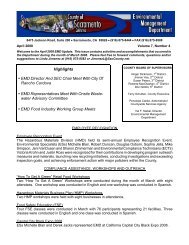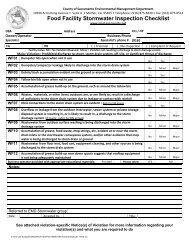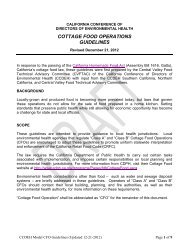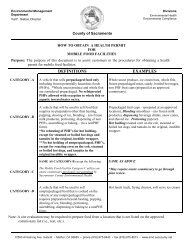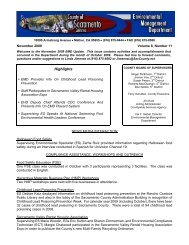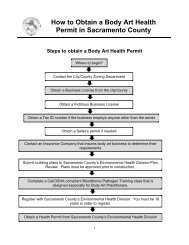California Water Well Standards, DWR Bulletin 74 ... - County of Glenn
California Water Well Standards, DWR Bulletin 74 ... - County of Glenn
California Water Well Standards, DWR Bulletin 74 ... - County of Glenn
- No tags were found...
Create successful ePaper yourself
Turn your PDF publications into a flip-book with our unique Google optimized e-Paper software.
Transition Seal. A bentonite-based transition seal, up to 5 feet in length, is <strong>of</strong>ten placed in theannular space to separate filter pack and cement-based sealing materials. The transition sealcan prevent cement-based sealing materials from infiltrating the filter pack. A short interval<strong>of</strong> fine-grain sand, usually less than 2 feet in length, is <strong>of</strong>ten placed between the filter pack andthe bentonite transition seal to prevent bentonite from entering the filter pack. Also, fine sandis sometimes used in place <strong>of</strong> bentonite as the transition seal material.Fine-grain forms <strong>of</strong> bentonite, such as granules and powder, are usually employed for atransition seal if a transition seal is to be placed above the water level in a well boring. Coarseforms <strong>of</strong> bentonite, such as pellets and chips, are <strong>of</strong>ten used where a bentonite transition sealis to be placed below the water level.Transition seals should be installed by using a tremie pipe or equivalent. However, some forms<strong>of</strong> bentonite may tend to bridge or clog in a tremie pipe.Bentonite can be placed in the well annulus in dry form or as slurry for transition seals. <strong>Water</strong>should be added to the bentonite transition seal prior to the placement <strong>of</strong> cement-based sealingmaterials where the bentonite is dry in the borehole. Care should be exercised during theaddition <strong>of</strong> water to the borehole to prevent displacing the bentonite.<strong>Water</strong> should be added to bentonite at a ratio <strong>of</strong> about 1 gallon for every 2 pounds <strong>of</strong>bentonite to allow for proper hydration. <strong>Water</strong> added to bentonite for hydration or to makea slurry shall be <strong>of</strong> suitable quality and free <strong>of</strong> pollutants and contaminants.Sufficient time should be allowed for bentonite transition seals to properly hydrate beforecement-based sealing materials are placed. Normally, 1/2 to 1 hour is required for hydrationto occur. Actual time <strong>of</strong> hydration is a function <strong>of</strong> site conditions.The top <strong>of</strong> the transition seal shall be sounded to ensure that no bridging occurred duringplacement.F. Placement <strong>of</strong> Annular Seal Material. All loose cuttings and other obstructions shall beremoved from the annular space before sealing materials are placed. Sealing may be accomplishedby using pressure grouting techniques, a tremie pipe, or equivalent. Sealing materialsshall be installed as soon as possible during well construction operations. Sealing materialsshall not be installed by "free-fall" from the surface unless the interval to be sealed is dry andless than 30 feet deep.Casing spacers shall be used within the interval(s) to be sealed to separate individual wellcasing strings from one another in a borehole <strong>of</strong> a nested monitoring well. The spacers shallbe placed at intervals along the casing to ensure a minimum separation <strong>of</strong> 2 inches betweenindividual casing strings. Spacershall be constructed <strong>of</strong> corrosion-resistant metal, plastic, orother non-degradable material. Wood shall not be used as spacer material.Any metallic component <strong>of</strong> a spacer used with metallic casing shall consist <strong>of</strong> the same materialas the casing. Metallic spacer components shall meet the same metallurgical specifications andstandards as the casing to reduce the potential for galvanic corrosion <strong>of</strong> the casing..The spacing <strong>of</strong> casing spacers is normally dictated by casing materials used, the orientation andstraightness <strong>of</strong> the borehole, and the method used to install the casing. Spacers shall not bemore than 12 inches in length and shall not be placed closer than 10 feet apart along a casingstring within the interval to be sealed, unless otherwise approved by the enforcing agency.E.-44-



